E-mail Setup
If you can access Microsoft Office Suite from Mamut Application Hosting,
you can set up your Outlook e-mail account. You will then have access
to your e-mail when logging in to the service, in the same way as Mamut Business Software, and you will be able
to use the integration between Mamut and Outlook.
Complete the steps below in order to set up your e-mail account and
transfer your e-mail and calendar items. You will need to know your e-mail
address, e-mail type, user name, password, server name etc. This is information
is available from your e-mail provider.
How to set up your e-mail account
Log in to Mamut Application Hosting
in the normal way. Select Mail Control
Panel in the welcome screen.
Please note that it may take some time when opening the control panel
for the first time.

Click the Add
button in order to register a new e-mail profile.
Enter a profile name in the Profile
Name field before clicking OK.
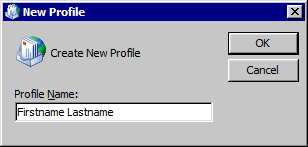
An Outlook wizard will be launched which must be completed
in order to set up your e-mail account. If you are unsure about how Outlook
should be configured, contact your e-mail provider.
When the wizard has been completed, select Always
use this profile at the bottom of the window. Make sure you select
the profile your created in step 3.
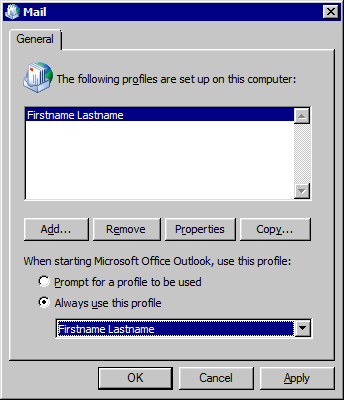
Click OK.
 You will now be able to start Microsoft Office
Outlook 2007 from the welcome screen. If you are prompted to enter user
name and password, enter the log in details for your e-mail account.
You will now be able to start Microsoft Office
Outlook 2007 from the welcome screen. If you are prompted to enter user
name and password, enter the log in details for your e-mail account.
 Note! When starting Outlook, the system
may return a message the e-mail file cannot be found. If this is the case,
you must browse to the file located at P:\AppData\Roaming\Microsoft\Office\outlook.pst.
Note! When starting Outlook, the system
may return a message the e-mail file cannot be found. If this is the case,
you must browse to the file located at P:\AppData\Roaming\Microsoft\Office\outlook.pst.
How to transfer e-mail and calendar items
from your local Outlook client
Open your local Outlook client.
Click File -
Import and Export.
In the Import and Export
Wizard window, select Export to
a file and click Next.
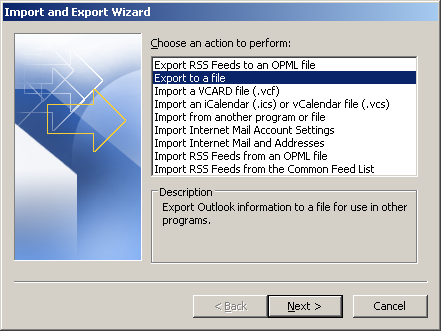
Select Personal Folder
File (.pst), and click Next.
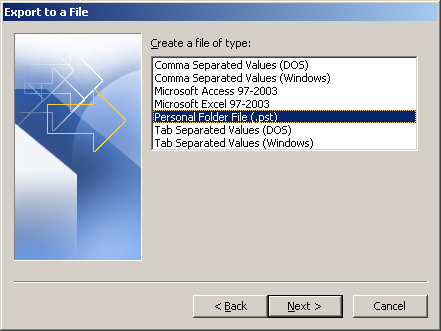
Select Personal Folders
and Include subfolders.
Click Next.
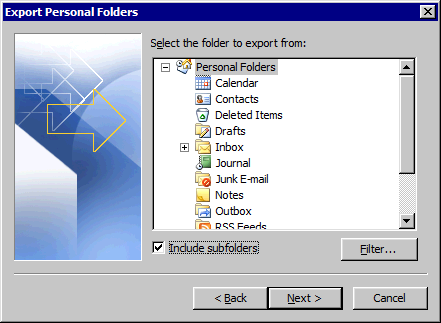
Click Browse
in order to choose where to save the .pst file. For easy access, we recommend
you create a new folder directly on the hard drive (C:) and the save the
file there. When you have chosen location and file name, click OK.
Finally, click Finish in order
to return to the export wizard.
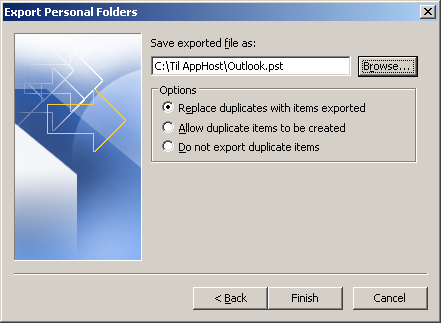
Click OK in
the Create Microsoft Personal Folders
window and wait while the file is created.
Log into Mamut Application Hosting
in the normal way. In the welcome screen, select Microsoft
Office Outlook 2007.

Click File -
Import and Export.
In the Import and Export
Wizard window, select Import from
another program or file and click Next.
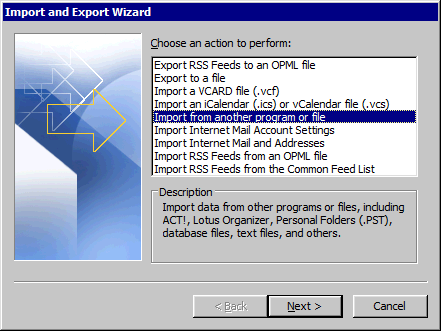
Select Personal Folder
File (.pst) and click Next.
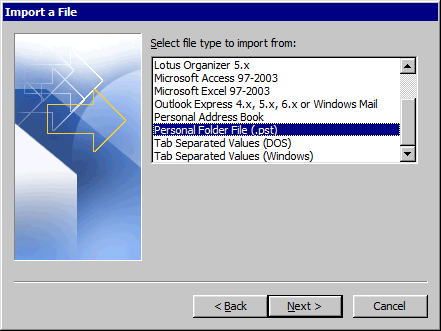
Click Browse
to navigate to the file.
If the following error message is displayed, click OK.

If you saved the file on your local hard drive, click
Computer and the local drive where
you saved the file.
Note! If your local drives are not displayed, make sure you
have selected Drives in the window
displayed at log in. Read more about this here.
Open the folder where you saved the .pst file in step
6.
Click once on the .pst-filen in order to select it.
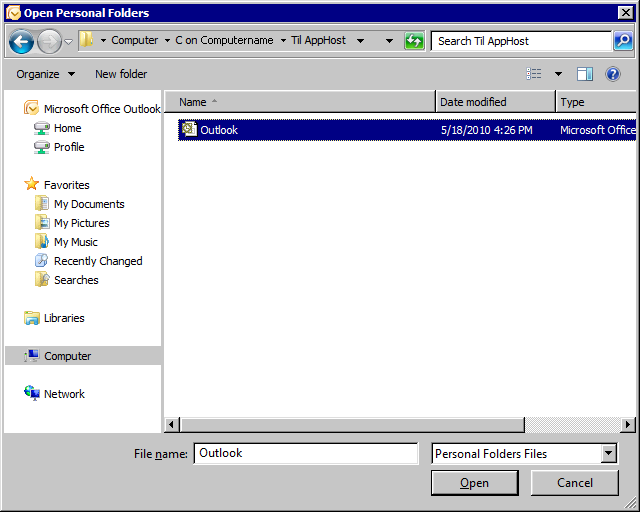
Press the [CTRL] key
on your keyboard while pressing the [C]
key (Ctrl+C) in order to copy the file.
Click Home (P:)
under Computer in the menu on
the left side of the window in order to select it.

Press the [CTRL] key
on your keyboard while pressing the [V]
key (Ctrl+V) in order to paste the file into the folder.
Wait for the .pst file to be copied to the server. This
may take some time, depending on the size of the file and the speed of
your Internet connection.
When the file has been copied, click Home
(P:) and select the .pst file. Click Open
and Next in the Import
Personal Folders window.
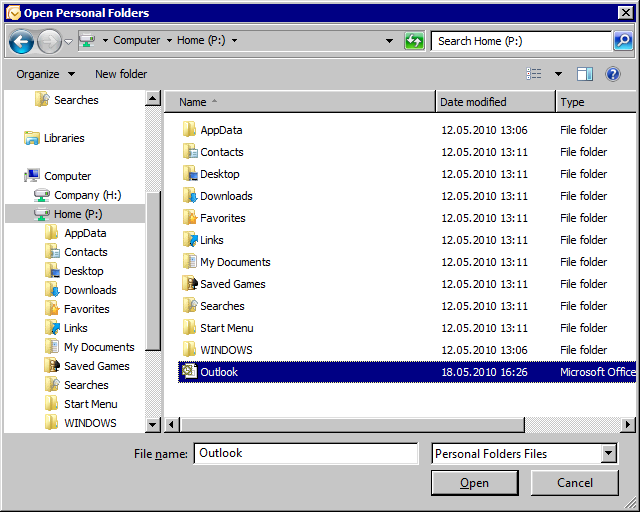
Make sure all settings have been defined in accordance
with the screen shot below. Click Finish
when you are done and wait while the .pst is being processed.
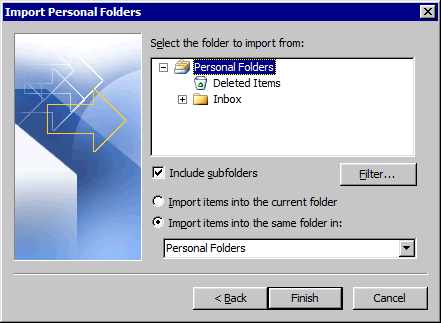
 All e-mail messages and calendar items will
now be available in Outlook via Mamut Application Hosting.
All e-mail messages and calendar items will
now be available in Outlook via Mamut Application Hosting.
Read more about:
Mamut Application Hosting
Using
the Service
Log
in
Frequently
Asked Questions



 You will now be able to start Microsoft Office
Outlook 2007 from the welcome screen. If you are prompted to enter user
name and password, enter the log in details for your e-mail account.
You will now be able to start Microsoft Office
Outlook 2007 from the welcome screen. If you are prompted to enter user
name and password, enter the log in details for your e-mail account. Note!
Note!










